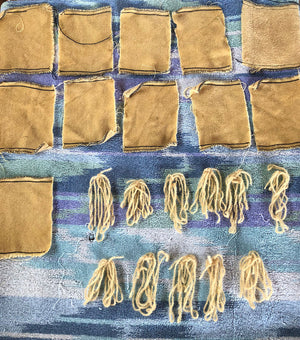Natural Dye Workshop - Dyeing with Protein Fibre

This past Saturday I conducted a Natural Dye workshop with the Saskatoon Spinners and Weavers Guild. There were 10 students and we were graciously hosted by one of the Guild members' to do the workshop at her home in the country, overlooking a gully of the South Saskatchewan river just near Waneskewin National Historic site. We began the workshop at 10:00 and finished at 4:00.
The focus of the workshop was on dyeing with protein fibre; wool and silk with natural dyes. These are good fibres to begin learning with as they are vibrant and yummy to see the finished results.
Everyone doubled up into groups of two, and we had five groups. I had pre-scoured the fabric (an essential part of the dyeing process which removes any grease from the factory) before the workshop started. It takes about an hour to scour the fabric. The basic steps of dyeing fabric or yarn with natural dyes are:
- Scour fabric
- Mordant fabric
- Dye fabric
Stainless steel pots were filled and set to boil and the fabric was introduced when the temperature reached it's 'ready' point. Groups were enthusiastic and dedicated to learning.

After the small pieces of fabric were mordanted the water was discarded and we started our pots boiling again for the dye process. Colours (dyes) were assigned to each group.

Attending to the dye vat and bringing the temperature up.

Inspecting the fibre and seeing some beautiful colors!

Swatches drying in the shade; brilliant yellow weld dyed swatches (foreground) and red-brown colour is with Weld (plant extract) with the addition of Brazilwood to the dye bath.

Waiting for the Cutch dye to boil.


Brilliant yellow with Weld (plant extract).

As an add-on, we had just enough time to see how the dyed fabric would take the smallest amount of ferrous sulphate. We were able to test just a small section to show everyone another possibility for additional colour ranges.
- Pomegranate with iron sulphate solution
- Pomegranate alone
- Cutch and iron sulphate solution
- Cutch as a stand-alone dye
- Weld and Brazilwood combination with iron sulphate solution
- Weld and Brazilwood combination on their own
- Chestnut with iron sulphate
- Chestnut alone
- Weld with iron sulphate
- Weld on it's own (vibrant yellow colour)



